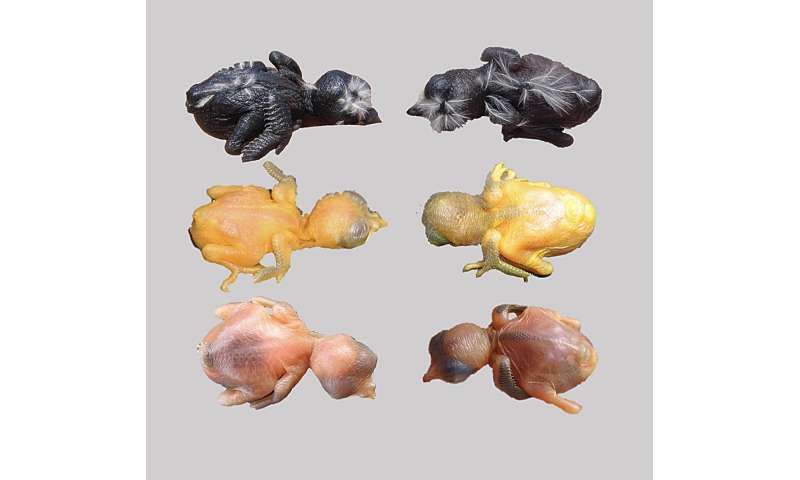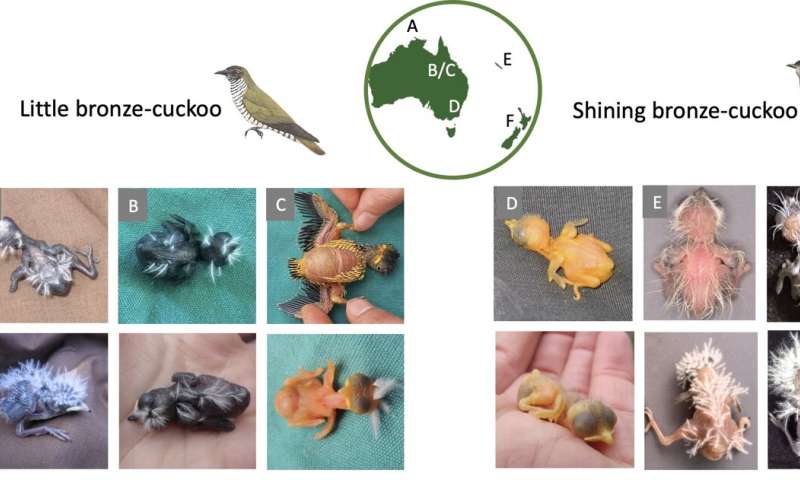This article has been reviewed according to Science X's editorial process and policies. Editors have highlighted the following attributes while ensuring the content's credibility:
fact-checked
peer-reviewed publication
trusted source
proofread
Study shows cuckoos evolve to look like their hosts—and form new species in the process

The theory of coevolution says that when closely interacting species drive evolutionary changes in each other this can lead to speciation—the evolution of new species. But until now, real-world evidence for this has been scarce.
Now a team of researchers has found evidence that coevolution is linked to speciation by studying the evolutionary arms race between cuckoos and the host birds they exploit.
Bronze-cuckoos lay their eggs in the nests of small songbirds. Soon after the cuckoo chick hatches, it pushes the host's eggs out of the nest. The host not only loses all its own eggs, but spends several weeks rearing the cuckoo, which takes up valuable time when it could be breeding itself.
Each species of bronze-cuckoo closely matches the appearance of their host's chicks, fooling the host parents into accepting the cuckoo.
The study shows how these interactions can cause new species to arise when a cuckoo species exploits several different hosts. If chicks of each host species have a distinct appearance, and hosts reject odd-looking nestlings, then the cuckoo species diverges into separate genetic lineages, each mimicking the chicks of its favored host. These new lineages are the first sign of new species emerging.
"This exciting new finding could potentially apply to any pairs of species that are in battle with each other. Just as we've seen with the cuckoo, the coevolutionary arms race could cause new species to emerge—and increase biodiversity on our planet," said Professor Kilner in the University of Cambridge's Department of Zoology, a co-author of the report.
The striking differences between the chicks of different bronze-cuckoo lineages correspond to subtle differences in the plumage and calls of the adults, which help males and females that specialize on the same host to recognize and pair with each other.
"Cuckoos are very costly to their hosts, so hosts have evolved the ability to recognize and eject cuckoo chicks from their nests," said Professor Naomi Langmore at the Australian National University, Canberra, lead author of the study.
She added, "Only the cuckoos that most resemble the host's own chicks have any chance of escaping detection, so over many generations the cuckoo chicks have evolved to mimic the host chicks."
The study revealed that coevolution is most likely to drive speciation when the cuckoos are very costly to their hosts, leading to a "coevolutionary arms race" between host defenses and cuckoo counter-adaptations.
-

Bronze-cuckoo nestlings on the left with the nestlings of their hosts on the right. Credit: Naomi Langmore -

Subspecies of the little bronze-cuckoo and the shining bronze-cuckoo track the appearance of their host's chicks across their geographic range. Credit: Naomi Langmore, Hee-Jin Noh, Rose Thorogood, Alfredo Attisano
A broad scale analysis across all cuckoo species found that those lineages that are most costly to their hosts have higher speciation rates than less costly cuckoo species and their non-parasitic relatives.
"This finding is significant in evolutionary biology, showing that coevolution between interacting species increases biodiversity by driving speciation," said Dr. Clare Holleley at the Australian National Wildlife Collection within CSIRO, Canberra, senior author of the report.
The study was made possible by the team's breakthrough in extracting DNA from eggshells in historical collections, and sequencing it for genetic studies.
The researchers were then able to combine two decades of behavioral fieldwork with DNA analysis of specimens of eggs and birds held in museums and collections.
The paper is published today in the journal Science. The study involved an international team of researchers at the University of Cambridge, Australian National University, CSIRO (Australia's national science agency), and the University of Melbourne.
More information: N. E. Langmore, Coevolution with hosts underpins speciation in brood-parasitic cuckoos, Science (2024). DOI: 10.1126/science.adj3210. www.science.org/doi/10.1126/science.adj3210
Journal information: Science
Provided by University of Cambridge



















